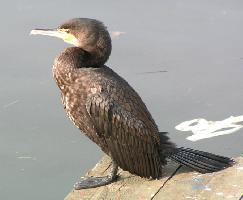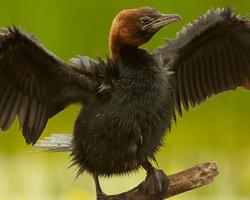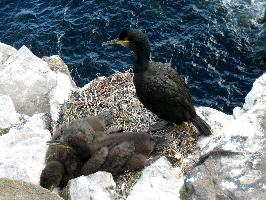
Description de l'animal
The Great Cormorant, scientifically known as Phalacrocorax carbo, is a large and impressive bird that is part of the cormorant family. With a widespread distribution, this species is found in various parts of the world, including North America, Europe, Asia, Africa, and Australia. The adaptability of the Great Cormorant to different environments is one of its most remarkable features, enabling it to thrive in both freshwater and marine habitats.Adult Great Cormorants have a distinctive appearance. They possess a body length that can range from 70 to 102 centimeters, and their wingspan is impressive, stretching from 121 to 160 centimeters. The weight of these birds can vary significantly, generally falling between 1.5 to 5.3 kilograms, with some geographical variation. Their plumage is predominantly dark with a greenish-black sheen, which beautifully reflects sunlight, giving them a somewhat iridescent look. During the breeding season, adults develop a white patch on their thighs and on their cheeks, which contrasts strikingly with their dark feathers. Their eyes are a striking green, and they have a robust, hooked beak that is yellowish at the base, making them adept at fishing.
One of the most fascinating aspects of the Great Cormorant's biology is its feeding behavior. These birds are excellent divers and can plunge from the air or the water's surface to catch fish with remarkable efficiency. They have been observed diving to depths of up to 45 meters, although they more commonly hunt in shallower waters. After catching their prey, they surface and are often seen holding the fish in their strong beak before swallowing it whole. Interestingly, their feathers get waterlogged during dives, reducing their buoyancy and enabling them to dive deeper. After fishing, they can be seen standing with wings outstretched to dry their feathers, a characteristic pose that is often associated with cormorants.
The breeding habits of the Great Cormorant are also noteworthy. They are colonial nesters, with colonies sometimes comprising thousands of birds. Nests are usually constructed in trees, on cliffs, or on the ground on islands in lakes and coastal regions. The nests are made from sticks and seaweed and lined with grass. Females typically lay three to four eggs, and both parents share in the incubation duties, which last about a month. The chicks are altricial, meaning they are born blind and featherless, and require considerable parental care before they fledge.
In terms of conservation, the Great Cormorant has faced challenges in the past, including persecution due to their perceived competition with fishermen. However, their population has remained stable and even increased in some areas, leading the International Union for Conservation of Nature (IUCN) to classify them as Least Concern. Nevertheless, they continue to face threats from habitat destruction and environmental pollution.
In conclusion, the Great Cormorant is a remarkable bird with a widespread distribution and a remarkable ability to adapt to different aquatic environments. Its distinctive appearance, fascinating feeding behavior, and complex social structures make it a subject of interest not only for ornithologists but also for nature enthusiasts around the world.
Animaux similaires
Nouvelles photos d'animaux
Top 10 des animaux
- Dolphin gull (Leucophaeus scoresbii)
- Diana monkey (Cercopithecus diana)
- Moustached guenon (Cercopithecus cephus)
- Galápagos tortoise (Geochelone nigra complex)
- Russian tortoise (Testudo horsfieldii)
- Stone loach (Barbatula barbatula)
- Japanese macaque (Macaca fuscata)
- Common flying dragon (Draco volans)
- Greek tortoise (Testudo graeca)
- Vendace (Coregonus albula)


